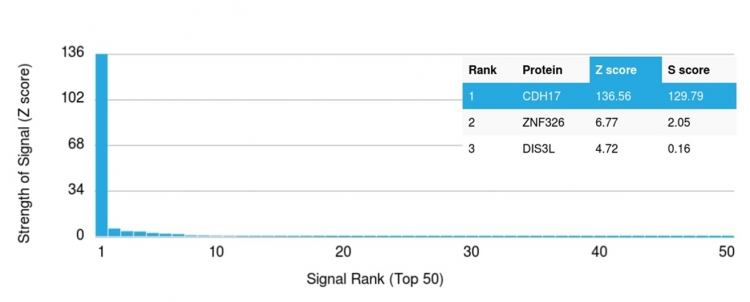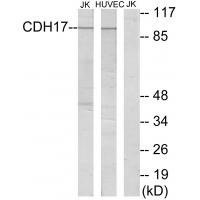![FACS analysis of MCF-7 cells using GTX03259 LI-Cadherin antibody [CDH17/2618]. Blue : Primary antibody Red : Isotype control FACS analysis of MCF-7 cells using GTX03259 LI-Cadherin antibody [CDH17/2618]. Blue : Primary antibody Red : Isotype control](https://www.genetex.com/upload/website/prouct_img/normal/GTX03259/GTX03259_20210622_FACS_w_23053123_294.webp)
FACS analysis of MCF-7 cells using GTX03259 LI-Cadherin antibody [CDH17/2618]. Blue : Primary antibody Red : Isotype control
LI-Cadherin antibody [CDH17/2618]
GTX03259
ApplicationsFlow Cytometry, ImmunoHistoChemistry, ImmunoHistoChemistry Paraffin, Other Application
Product group Antibodies
TargetCDH17
Overview
- SupplierGeneTex
- Product NameLI-Cadherin antibody [CDH17/2618]
- Delivery Days Customer9
- Application Supplier NoteIHC-P: 1-2ug/ml. FACS: 1-2microg/million cells. *Optimal dilutions/concentrations should be determined by the researcher.Not tested in other applications.
- ApplicationsFlow Cytometry, ImmunoHistoChemistry, ImmunoHistoChemistry Paraffin, Other Application
- CertificationResearch Use Only
- ClonalityMonoclonal
- Clone IDCDH17/2618
- Concentration0.2 mg/ml
- ConjugateUnconjugated
- Gene ID1015
- Target nameCDH17
- Target descriptioncadherin 17
- Target synonymscadherin 17, LI cadherin (liver-intestine); cadherin-16; cadherin-17; CDH16; HPT1; HPT-1; HPT-1 cadherin; human intestinal peptide-associated transporter HPT-1; human peptide transporter 1; intestinal peptide-associated transporter HPT-1; LI cadherin; liver-intestine cadherin
- HostMouse
- IsotypeIgG2b
- Protein IDQ12864
- Protein NameCadherin-17
- Scientific DescriptionThis gene is a member of the cadherin superfamily, genes encoding calcium-dependent, membrane-associated glycoproteins. The encoded protein is cadherin-like, consisting of an extracellular region, containing 7 cadherin domains, and a transmembrane region but lacking the conserved cytoplasmic domain. The protein is a component of the gastrointestinal tract and pancreatic ducts, acting as an intestinal proton-dependent peptide transporter in the first step in oral absorption of many medically important peptide-based drugs. The protein may also play a role in the morphological organization of liver and intestine. Alternative splicing results in multiple transcript variants. [provided by RefSeq, Jan 2009]
- Storage Instruction-20°C or -80°C,2°C to 8°C
- UNSPSC12352203

![IHC-P analysis of human colon tissue using GTX03259 LI-Cadherin antibody [CDH17/2618]. IHC-P analysis of human colon tissue using GTX03259 LI-Cadherin antibody [CDH17/2618].](https://www.genetex.com/upload/website/prouct_img/normal/GTX03259/GTX03259_20210622_IHC-P_w_23053123_257.webp)







